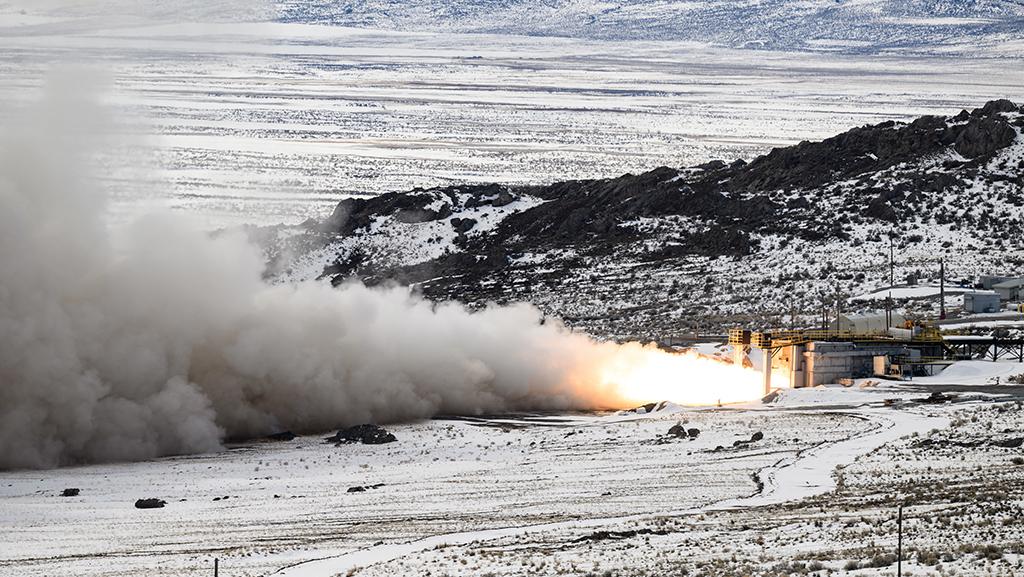This article is published in Aviation Week & Space Technology and is free to read until Aug 17, 2024. If you want to read more articles from this publication, please click the link to subscribe.

The U.S. Air Force conducted the first full-scale static test firing of one of the LGM-35A Sentinel solid rocket motors at Northrop Grumman’s facility in Promontory, Utah, in March 2023.
The Pentagon’s new intercontinental ballistic missile will force the U.S. Air Force to overhaul its budget plans in the long term, as the costs for the LGM-35A Sentinel have exploded by 81% over the original estimation.
That was the finding of a seven-month review of the Northrop Grumman program that was completed in early July. The overall Sentinel program is now projected to cost $140.9 billion, with much of the cost growth expected to come beyond current Air Force planning.
- U.S. Defense Department and Air Force did not understand the scope of LGM-35A’s work
- A delay of “several years” is expected
The review was sparked by a Nunn-McCurdy breach, which opens the legally required need for senior Defense Department leaders to study a program and determine if it is necessary for national security when costs spike more than 25% from original estimates. Bill LaPlante, the Pentagon’s undersecretary for acquisition and sustainment, told reporters the program must continue, but the Air Force needs to restructure it to try to keep costs under control.
“There are reasons for this cost growth, but there are also no excuses,” LaPlante said. “We fully appreciate the magnitude of the cost, but we also understand the risks of not modernizing our nuclear forces and of not addressing the very real threats we confront.”
As part of the process, LaPlante rescinded the program’s Milestone B approval from September 2020—the decision that started its engineering and manufacturing development phase. LaPlante said that in retrospect, it is clear the department did not understand accurately the scope of the program’s massive infrastructure work.
In addition to developing the missile itself, implementing the Sentinel program will require upgrades to 450 missile silos and hundreds of other facilities across the Great Plains and Mountain West. At the current schedule, the Air Force would have to update one silo per week on average for nine years, service officials have said.
“It’s important to note that Sentinel is truly a historic program to modernize the land leg of the nuclear triad, and its scale, scope and complexity are something we haven’t attempted as a nation for over 60 years,” LaPlante said.
The review looked specifically at the “complexity” of launch facilities, and the Air Force—as part of the restructuring plan—will find ways to scale back that design to save money, he said. This also will allow a shorter transition from the existing Minuteman III launch facilities to the Sentinel.
While some in Washington, including vocal members of Congress who focus on nonproliferation, have called for cutting back on the program or finding other ways to implement the ground-based segment of the nuclear triad, LaPlante said the review made clear that the nation needs the new ICBM. Ideas such as extending the life of the Minuteman III or shifting to a mobile launcher were either cost-prohibitive or would not meet requirements.
Lawmakers including Sen. Elizabeth Warren (D-Mass.) and Rep. John Garamendi (D-Calif.) have been openly critical of the Pentagon’s review. In a June 24 letter to Defense Secretary Lloyd Austin, 13 lawmakers expressed concerns that officials, including LaPlante and senior Air Force leaders, said the program had to continue even before the Nunn-McCurdy review began.
“Given the imperative of advancing nuclear policies that promote stability and prevent escalation, we demand a thorough review of all alternatives,” the letter states. “At this critical juncture, we must not allow momentum and preconceived notions to cloud our judgment in reviewing whether this program provides for our national security or is wasting U.S. taxpayer dollars.”
Andrew Hunter, assistant secretary for acquisition, technology and logistics, said the Air Force plan to restructure the program will take 18-24 months. LaPlante said the specific delay to the program is not set yet, but it is expected to be “several years.”
Since most of the projected cost growth is expected later in the program, beyond 2030 or so, the Air Force does not yet know the impact to other modernization efforts. The service plans its budget in five-year increments, known as the Future Years Defense Program, so it does not yet know what trade-offs will be required, said Lt. Gen. Jim Slife, the service’s vice chief of staff.
There have been hints already, though. Air Force Secretary Frank Kendall told Aviation Week in June that the service’s budget planning is tight and forcing him to look at decisions that would have been unthinkable previously. This includes a reconsideration of the Next-Generation Air Dominance aircraft planned to replace the Lockheed Martin F-22.





